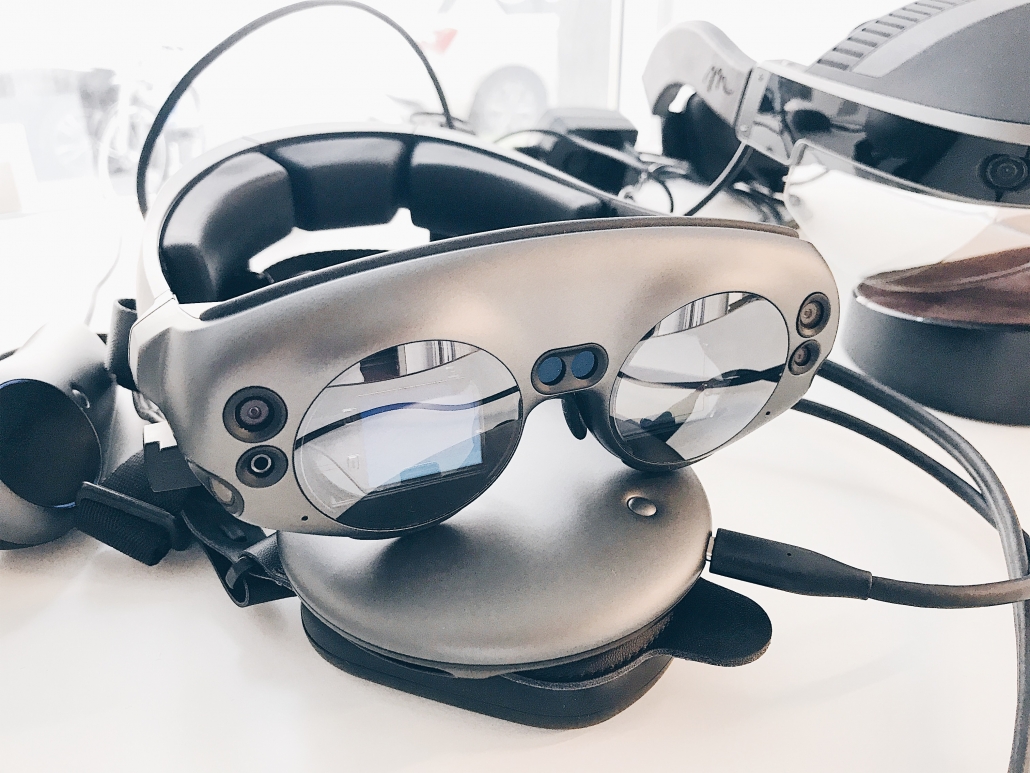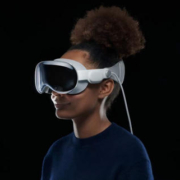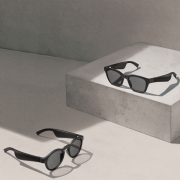- The birth of the new, augmented reality - 2. October 2018
A review of the long-awaited Magic Leap One augmented reality platform
Hovering in front of me is a virtual shelf with various objects and categories for me to choose from. I use the controller to grab a small rocket, take it off the shelf and place it in the room. Thwack! The small spacecraft is rooted in front of me like something out of a comic book or video game. I walk around it and look at it from all sides.
To my colleagues, I look a bit like Vin Diesel in Riddick. Not because of the muscles, unfortunately, but because of the futuristic glasses I am wearing. This is the headset of the new AR platform Magic Leap One. I had the opportunity to test the new system in the “Creator Edition” just a few days after its release in our Plan.Net Innovation Studio in Munich.

The augmented image viewed through the glasses is slightly transparent, I can still see the pattern of the carpet behind the rocket – at least if I consciously try. The colours are bright and cheerful, as they should be – for a brief moment I have the desire to reach out a finger and poke the rocket. Immersion Level 1 is quickly achieved.
Originally it was said that the glasses would be able to project images on six different levels in order to represent objects in different degrees of sharpness in connection with the tracking of the eye movement. Experts have already complained that the hardware only features two of these levels, which significantly reduces the effect of the experience. I cannot understand that, because, as I see it, the overall performance of the graphics still does not come close to being able to capitalise on these six levels. Everything still looks very video game-like and the resolution is not so high that this level of detail would play a crucial role in the sensory experience.
The rocket is still stuck there. “Was that it?” I ask myself. I click on the rocket and it whizzes off with a “woosh!” No idea where it’s gone. Then I put a cowboy hat on one of my colleagues and give him a moustache from the objects library, which is still floating behind me in the room. At least until he leaves, and his hat and moustache are left hovering in space. Spoilsport.
Then I grab a few things from the next category in the library, to quickly set up a kind of marble run. I can work on my design from all angles, while I talk to my colleagues and look them in the eye. It’s like I’m just wearing sunglasses, all the while working on a setup that has no regard for the laws of physics, but is otherwise quite realistic to me. Anyway, the whole thing quite quickly becomes pretty routine and natural. Then I grab the marble from the library and listen to it rumble through my tubing system, fall onto a trampoline, fly across the room and bounce off a real table leg in the room thanks to the real-world tracking.
I look at my colleagues, beaming like a little kid and say: “That’s awesome, right?”. My three colleagues look at me, their hands in their pockets, and almost simultaneously shrug their shoulders. Immersion Level 2! Only I can see my marble track – I had forgotten that. This is one minor disadvantage – sharing the experiences is not quite so easy.

The second app that I can test is about the Icelandic band Sigur Rós. They spent five years learning how to create or compose music in mixed reality, in collaboration with Magic Leap. Tónandi is the name of the app and it has exceptional gesture control – this app does not require a controller. The task is to move through different levels or worlds that come to life with gestures. For example, you can collect stones, prowl through virtual grass and prod virtual jellyfish. When you have more or less completed a scene, it creates a kind of wormhole, through which you plunge into the next scene. Impressive!
The variety of the gestures you can perform using your own hand movements is a huge advantage. There are eight different gestures that the system recognises. Developers can design and add even more gestures. From my perspective, this is a huge advantage of the Magic Leap system. Microsoft currently only offers two defined gestures. I am someone who develops interfaces and products for the digital world and is always driven by the desire for the best possible user experiences and relevant products. So, the various possibilities for implementing different gestures in this context are obviously of great interest to me. I am convinced that the usage of a product must be regarded as having a direct impact on branding. This means that our work should be focussed not only on user satisfaction, but also brand image. With details such as meaningful gesture control, offers are accepted much faster and can become much more immersive experiences much sooner.
The gestures are often still very unnatural in practice. It can of course still be difficult to reach for a virtual stone, and high latencies leave you uncertain about whether you have grabbed it successfully or not. However, allowing developers to develop their own gestures enables testing and experimentation, ensuring faster development of user experiences and making the operation of extended realities as natural as possible.

In conclusion, all in all the first version of the Magic Leap One offers a mega-experience and is an important step in the direction of consumer-facing AR for the living room. The hardware is rock solid, but Magic Leap still has some details to work on. The massive hype built up in recent years by the communications is the major factor negatively impacting on the overall impression. Because the Creator Edition cannot really fulfil this dream just yet. Just like with all modern platforms, they are now asking for the opinions of the third-party development community. This will quickly reveal the actual potential of the platform and provide Magic Leap with good support for further development of hardware and software.
And what does it cost? If you want to buy one of these coveted devices, you will have to get it from the USA, and it will cost you the equivalent of just under EUR 2,000. Not to mention the customs duty for bringing it back to Germany.
This page is available in DE






